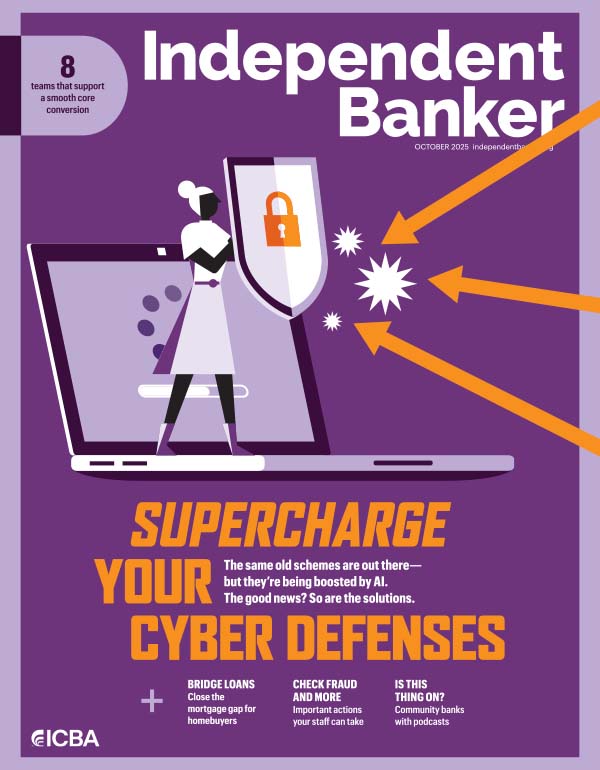Community banks should regularly assess and mitigate any potential physical threats to their branches—and they should do it in a systematic way, so no potential risks are overlooked.
Community banks face a host of physical security threats, ranging from in-branch burglaries to escalating violence and ATM theft, says Brian Hilinski, director of sales, financial for the U.S. eastern region for 3SI Security Systems in Malvern, Pa.
“All of these threaten people, property and assets, not to mention damage to the brand and even disruption to day-to-day operations,” Hilinski says. “For these reasons, a proactive approach is critical.”
The importance of an annual security review
To stop security incidents, community banks must understand the risks and deploy the right solutions to prevent or address the problem. Hilinski recommends that banks conduct an annual security review that evaluates risks based on their specific branch locations, geography, history, building and ATM configuration.
“At 3SI, we approach security assessments for financial institutions by ‘zone,’” Hilinski says. “These are critical areas inside and outside the branch that present distinct security challenges and demand different strategies. In each zone, we deploy tactical solutions designed to either deter, detect, deny or detain.”
Community banks conducting physical risk assessments should systematically think through all of the vulnerabilities of each physical asset and how the bank may be potentially at risk, says Scott Anchin, ICBA’s vice president, operational risk and payments policy.
“That really gives banks an opportunity to be very thoughtful about how they move forward,” he says. “I think that all too often there’s a focus on day-to-day operations, and banks don’t take the time to sit down and map all this. The process of conducting the evaluation in a systematic way gives them that opportunity.”
Once banks have a baseline of assets, vulnerabilities, threats and opportunities for mitigation, they can plot the changes over time—particularly risks are increasing or decreasing, Anchin says.
“It’s important that you have a regular cadence. It’s not a one-time activity, as the physical assets that you possess change, and vulnerabilities and threats also change,” he says.
Security starts with staff and branch design
A culture of security begins with the staff, so banks should make sure they are involved in these types of assessments, Anchin says. As staff changes, banks must reassess the threat from potential insider risk.
When designing new branches, community banks can make choices at little cost that can lessen potential vulnerabilities and threats toward physical assets, Anchin says. For example, branches should have large windows to increase visibility of what’s happening both on the inside and outside, and vegetation should be minimal to prevent would-be bad actors from hiding and potentially ambushing customers and employees.
“Creating a secure environment helps the staff to feel comfortable and do their best work, and it also builds trust and good relations with customers and with the community,” Anchin says.
Community banks should also partner with local law enforcement, business improvement districts and other local merchants that can collectively help to improve physical security.
According to Anchin, “One of the strengths that community banks have is that they are very connected with their communities, and so there’s a lot of opportunities to form these partnerships.”
The five security zones of a community bank
Interior back. This is the area where cash and other assets are held in safes, lockboxes and stored cartridges. These sections are at high risk of theft and require round-the-clock protection. Here, banks can deny access with the use of locks and robust access controls, plus surveil with integrated tracking solutions and video management systems.
Interior front. In the front of the house, cash is constantly being transacted from teller drawers and ATMs. This area requires safe and discreet security to ensure customer and staff safety in the event of a burglary. This is also a good place to deter and detect with cameras and public view monitors to let thieves know they are being monitored.
Entry and exit. These high-traffic areas are difficult to monitor. Use of automated alerts from video in parking lots and at entrances can help detect behaviors or individuals of interest before they gain entry to the back of the branch.
Exterior Outside. the branch is the best place to stop a problem before it becomes an event. This is a zone of detection and deterrence. Perimeter security systems, cameras and access control all play important roles in keeping this area secure.
Community. Once a crime has been committed, the community around the bank can be at risk. It’s critical to detain criminals with the use of technologies that protect the stolen assets in transit, following them using GPS technology so that police can pursue and recover assets when and where it is safe, and prosecute criminals to the extent of the law.






